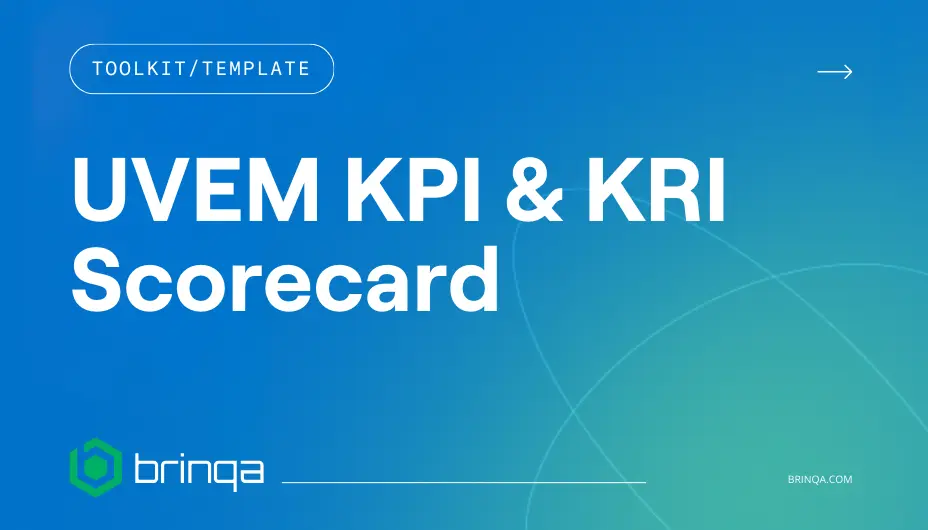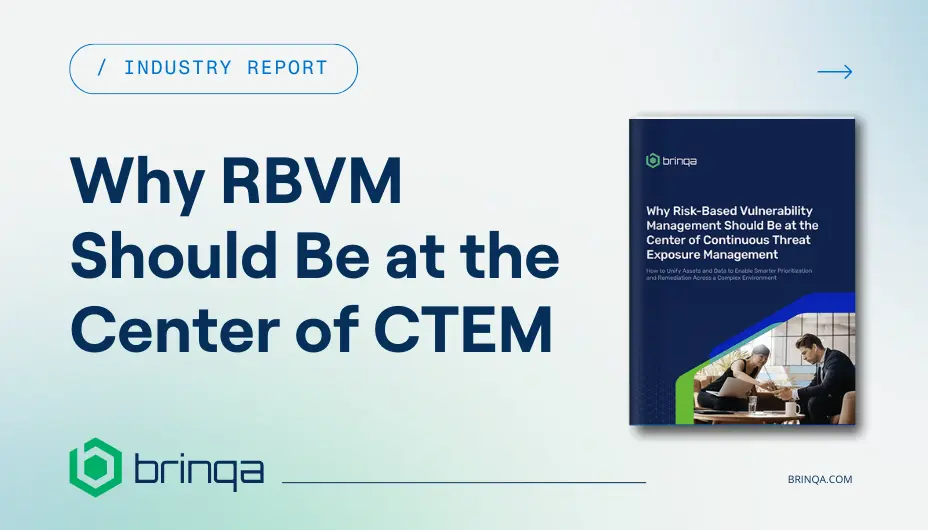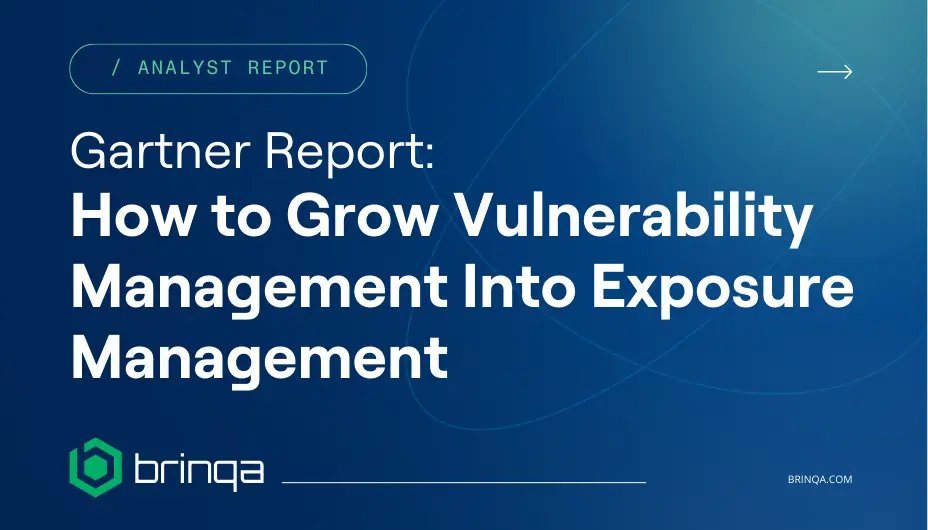The Top 15 KPIs and KRIs to Measure Unified Vulnerability and Exposure Management
by Brinqa, Security Experts//12 min read/

Vulnerability and exposure management teams track key performance indicators (KPIs) and key risk indicators (KRIs) to assess program effectiveness, guide prioritization, and demonstrate remediation progress to stakeholders. However, unified vulnerability and exposure management (UVEM) metrics differ from those that measure traditional vulnerability management by focusing on business impact, exploitability, and context-driven prioritization instead of just asset coverage, false positives, and burn-down rates.
This post:
- Explains KPIs and KRIs
- Identifies the challenges in managing UVEM metrics
- Defines the top UVEM KPIs and KRIs
- Discusses why the metrics matter
- Describes best practice target ranges for each of the key metrics based on industry benchmarks, compliance expectations, and maturity models (e.g., NIST, ISO 27001, Gartner CTEM guidance).
For more information on transforming UVEM metrics into actionable reporting, check out How to Report Vulnerability Risk to Executives and the Board: Dashboards, Metrics & Best Practices.
What Are KPIs and KRIs?
KPIs and KRIs are metrics used to measure how well processes are running and if risk is increasing. Each type of metric is important for vulnerability teams to track and measure.
A key performance indicator (KPI) is a measurable value that shows how effectively an organization is achieving its strategic and operational goals. For example, KPIs measure how effectively your team is performing vulnerability management activities and achieving objectives like speed, coverage, and efficiency.
A key risk indicator (KRI) is a metric used to measure the level of risk exposure or the likelihood of a risk event occurring. KRIs provide early warning signals about emerging or potential threats that could negatively impact objectives. Risk management, cybersecurity, compliance, and governance teams use KRIs to proactively identify and mitigate risks.
Why UVEM KPIs and KRIs Are Difficult to Track
Unified vulnerability and exposure management (UVEM) KPIs and KRIs are much more complex to track than traditional CVSS-based metrics, with organizations often facing both technical and organizational challenges.
Data Integration
UVEM relies on correlating data from multiple systems and sources, including asset inventories, vulnerability scanners, threat intel feeds, CMDBs, and internal business context — all of which live in siloed platforms. Assets may also be labeled differently across systems, making correlation difficult. Without automation, teams often resort to managing their vulnerabilities with spreadsheets or manual processes — a slow and error-prone method.
Lack of Context
UVEM requires enriching technical data with business and threat context, but some organizations don’t have a clear understanding of which systems are most business-critical and some may even lack clear asset ownership. Also, not all vulnerability scanners include real-time exploitability or threat actor data. Limited business and threat context can stall prioritization and accountability.
Prioritization and Risk Scoring Inconsistency
UVEM represents a shift from volume-based to risk-weighted decisions, but different tools may use incompatible formulas or weighting methods. Without normalized risk scoring, too many vulnerabilities could be labeled as “high risk,” overwhelming teams. Also, exploit availability or business impact can change over time, but some systems don’t auto-adjust risk scores.
Metric Definition Across Teams
It’s difficult to standardize UVEM metrics across the organization. For example, “high risk” or “critical asset” may mean different things to different teams. Traditional remediation SLAs (e.g., fix in 30 days) don’t always align with risk-based urgency. When security, IT, and compliance use different metrics, it’s hard to build trust in the data.
Reporting Hurdles
UVEM metrics are harder to explain to executives and non-technical stakeholders. Raw risk scores or exploit chains may be too technical and confuse leadership. If UVEM dashboards don’t show impact on business services, they miss the point. As visibility improves, it may look like risk is increasing when it’s actually just better measurement.
Operationalization
Even with perfect metrics, organizations struggle to act on them. Fixes may not be validated or tracked against real-world exploitability. And, risk-based thinking is a big shift for teams used to CVSS/SLA compliance.
Ready to focus on the metrics that matter most? Download our customizable UVEM KPI and KRI Scorecard.

Top UVEM Metrics & Best Practice Ranges
The table below organizes KPIs and KRIs by stage of the vulnerability management lifecycle:
- Centralize vulnerability and exposure data
- Prioritize risks based on external threat intelligence and internal business context
- Remediate the most impactful vulnerabilities
- Report on progress for SLAs and compliance
| Category | Type | Definition | Best Practice Range | Why It Matters |
|---|---|---|---|---|
Centralize | KPI | How many assets are being scanned on schedule. | Scheduled or event-driven | Ensures no assets are overlooked. |
Centralize | KRI | Percentage of assets with unknown owners. | Manage to near zero | Gaps in asset accountability increase risk of unmanaged or unpatched systems. |
Centralize | KRI | Percentage of systems managed. | ≥ 95% for most organizations | Vulnerabilities on “unknown” assets go unremediated, creating blind spots attackers can exploit. |
Prioritize | KPI | Number of vulnerabilities that meet a defined risk threshold (e.g., CVSS + exploit + asset value). | Should decrease over time | Tracks truly relevant issues, not noise. |
Prioritize | KPI | % of exposures validated by external threat intelligence. | ≥ 90% of critical risk scoring includes threat context (e.g., CISA KEV, Ransomware IOCs) | Ensures UVEM is driven by real-world risk. |
Prioritize | KRI | Percentage of business critical assets with exploitable vulns trending up. | ≤ 5% of total asset population | Indicates systemic or process-level breakdowns. |
Prioritize | KRI | Count or percentage of high-risk vulns on critical business systems. | 0 (ideal); manage to near zero | Highlights unacceptable risk concentration. |
Prioritize | KRI | % of known exploitable vulnerabilities (e.g., CISA KEV, Exploit-DB) currently present in the environment. | < 2% of total vulnerabilities | Highlights attack surface exposure. |
Remediate | KPI | % of high-risk vulnerabilities (based on threat context and business impact) remediated within SLA. | ≥ 90% | Indicates SLA compliance and process efficiency. |
Remediate | KPI | Average time to remediate high-risk vulnerabilities with known exploits or high business impact. | < 3-7 days (critical) < 30 days (high) | Reflects operational responsiveness to real threats. |
Remediate | KRI | % of critical vulnerabilities unpatched > 30 days | 0 criticals out of SLA | Signals high-risk items lingering too long; direct indicator of elevated exposure. |
Report | KPI | % decrease in cumulative risk scores over the last 30/60/90 days. | Continuous downward trend | Indicates overall program effectiveness. |
Report | KPI | Percent of assets in scope for compliance frameworks (e.g., PCI, HIPAA) that meet vulnerability requirements. | 100% of in-scope systems | Maps UVEM performance to regulatory obligations. |
Report | KRI | Average or max risk score per business unit or function. | Visibility where rated | Useful for driving accountability and prioritization across teams. |
Report | KRI | Risk levels specifically for business-critical systems or crown jewel assets. | ≤ medium risk | Aligns security priorities with business impact. These systems should be prioritized for protection. |
Report | KRI | Average risk score for all in scope assets in org. | Continuous downward trend | Shows point-in-time snapshot of risk posture. |
Five Steps to Mature Your UVEM KPIs and KRIs
Every organization will measure risk in the way that is right for their business, but there are five fundamental principles that form the foundation for establishing consistent UVEM metrics:
- Create clear, consistent definitions and thresholds for UVEM metrics; align them with risk appetite and business SLAs. You can’t manage what you can’t measure, so bring all stakeholders together to define the right KPIs and KRIs for your organization.
- Invest in a centralized UVEM platform that integrates and normalizes inputs from across your security and threat intelligence toolset. This will improve your team’s ability to see all assets and scan results in a single location, which will enable them to apply consistent prioritization logic across all exposures.
- Adopt dynamic risk scoring that includes threat intelligence for exploitability (e.g., CISA KEV, VulnCheck, etc.), asset context, and business impact—and keep it updated. Doing so will improve prioritization efforts, increasing program performance and reducing risk to the business.
- Establish SLAs based on risk, automate ticketing workflows, and create remediation feedback loops based on prioritized risks. Automating the remediation process will improve team efficiency and reduce risk exposure.
- Build role-specific dashboards (e.g., for execs, security analysts, and IT ops) that link technical risk to business impact. Presenting clear metrics that meet stakeholder expectations improves business risk visibility.
How Brinqa Helps Manage UVEM KPIs and KRIs
The Brinqa vulnerability and exposure management platform is a purpose-built solution for centralizing, prioritizing, remediating and reporting on exposures across complex environments. The platform offers:
- Unmatched Integrations: Connects with more than 220 tools across IT, cybersecurity, and business systems to consolidate findings from infrastructure, applications, and cloud.
- Enriched Prioritization: Automatically layers on threat intelligence — such as exploitability, business impact, and risk context — to streamline prioritization and drive faster mitigation.
- Remediation Orchestration: Automates ticketing, grouping, ownership assignment, and SLA tracking, enabling teams to focus on reducing real risk — not just working through checklists.
- Custom Dashboards and Reports: Gives stakeholders tailored views of risk, delivering greater clarity and decision-making power than generic, out-of-the-box reports.
- Scalable, Expert-Driven Deployments: Brinqa delivers tailored solutions built around your environment and risk posture — going far beyond the limitations of quick, cookie-cutter deployments.
With Brinqa, security teams can unify, contextualize, and act on prioritized vulnerability data at scale while measuring the performance of their UVEM program and risks to the organization.
Ready to focus your security team on what matters most? Download our customizable UVEM KPI and KRI Scorecard or request a demo to see how Brinqa helps enterprise teams measure their essential UVEM metrics.
Frequently Asked Questions (FAQ)
What is the difference between a KPI and a KRI in UVEM?
A KPI measures how well your vulnerability management program is performing (e.g., how fast vulnerabilities are being remediated), while a KRI highlights areas of increased risk (e.g., how many critical vulns remain unpatched on internet-facing systems).
Why are both KPIs and KRIs important in UVEM?
KPIs help improve process efficiency and demonstrate progress. KRIs, on the other hand, serve as early warning signals for emerging threats and risk accumulation. Together, they give a full view of performance and exposure.
How do I determine which KPIs and KRIs to track?
Focus on what aligns with your organization’s risk appetite, compliance needs, and business priorities. For example, if protecting customer data is a top priority, track KRIs like exploitable vulnerabilities in customer-facing systems.
How many KPIs and KRIs should we track?
Focus on 3 to 5 high-value KPIs and KRIs for each stage of your process. This should be enough for meaningful oversight while avoiding dashboard overload.
What are the best KPIs to demonstrate the effectiveness of our UVEM program?
- Mean Time to Remediate (MTTR)
- % of vulnerabilities remediated within SLA
- Risk reduction over time
- Asset scan coverage
What are the most critical KRIs for early detection of risk?
- % of exploitable vulnerabilities on high-value assets
- % of critical vulnerabilities older than 30 days
- Gaps between CMDB and scanner coverage
- External-facing systems with active CVEs
- Unscanned or orphaned assets
How often should RBVM KPIs and KRIs be reviewed?
At least monthly for strategic oversight, and weekly or even daily for operational dashboards — especially if using automated tooling and real-time threat intelligence.
What tools can help me track KPIs and KRIs in UVEM?
UVEM platforms like Brinqa can consolidate vulnerability, asset, and threat intelligence data into risk-based metrics. SIEMs, CMDBs, and dashboards (e.g., Power BI, Splunk) can also assist, and are usually inputs into UVEM platforms.
How do I know if my metrics are actually reducing risk?
If your KRIs are trending down (e.g., fewer critical vulns on key assets) and your KPIs remain strong (e.g., timely remediation, full asset coverage), your program is likely reducing real-world risk.
What are some signs that I’m tracking the wrong metrics?
- You’re hitting KPIs, but breach or exposure risk is rising.
- Your metrics focus on volume (e.g., # of vulns fixed) rather than risk.
- Business stakeholders don’t understand or act on your reports.


